Meal prepping with sunlight can revolutionize your kitchen routine while cutting energy costs and boosting food quality. You'll notice immediate benefits from natural light's ability to enhance ingredient visibility, reduce eye strain, and create an uplifting cooking environment. Solar cooking methods can reach temperatures up to 400°F, making them perfect for soups, stews, and steamed vegetables while reducing your carbon footprint. When you combine strategic window placement with sun-powered cooking techniques, you'll save up to 66% on energy costs. Plus, natural light acts as a natural deodorizer and mold inhibitor, ensuring fresher meals. There's much more to discover about harnessing the sun's power in your kitchen.
Natural Light Kitchen Setup
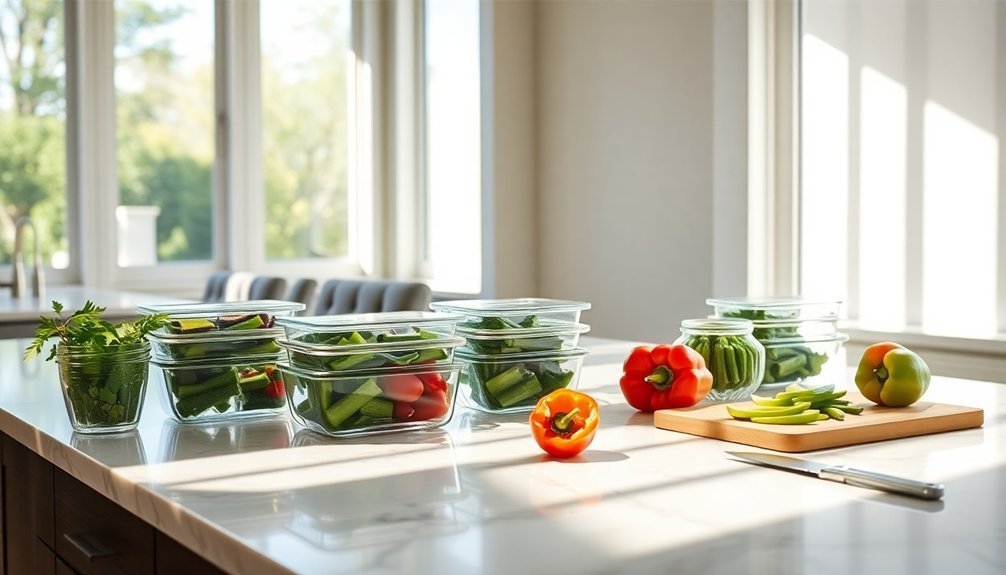
Every well-designed kitchen deserves the transformative power of natural light. When you're preparing meals, sunlight streaming through your windows creates an inviting atmosphere that makes cooking more enjoyable.
You'll notice how natural light enhances the colors and textures of your kitchen surfaces, from gleaming countertops to polished appliances. The eco-friendly energy savings from using natural daylight instead of artificial lighting can significantly reduce your monthly utility costs.
Setting up your kitchen to maximize sunlight isn't just about aesthetics – it's about creating a sanctuary where indoor and outdoor elements blend seamlessly.
You'll find that a naturally lit space feels more spacious and welcoming, perfect for those long meal prep sessions.
Consider how the sunlight moves through your kitchen throughout the day, and arrange your prep stations to take advantage of the best lighting spots.
A bright, well-lit kitchen becomes your culinary canvas, inspiring creativity and making every cooking session more pleasurable.
Morning Meal Prep Benefits
You'll feel more energized starting your day with natural light streaming through your kitchen windows while preparing meals.
Taking advantage of morning sunlight during meal prep helps you maintain a consistent routine and boosts your productivity levels right from the start. This morning routine allows for stress-free commutes since you won't be rushing to figure out what to eat.
Setting up your ingredients and containers in natural light not only saves precious morning time but also creates an uplifting environment that carries positive energy throughout your day.
Energized Start Each Day
While rushing to get ready in the morning can feel overwhelming, meal prepping transforms your daily routine into a streamlined experience that energizes both body and mind. Plus, using quality storage containers helps maintain freshness and organization throughout the week.
You'll boost your mental performance with balanced nutrients that enhance focus and productivity throughout the day. By having nutritious meals ready, you're setting yourself up for sustained energy levels and better blood sugar control.
- Your pre-planned breakfast guarantees peak intake of essential nutrients like folate, calcium, and iron, supporting your overall well-being.
- You'll skip the stress of last-minute decisions and gain precious moments to spend with family or perfect your morning routine.
- Without the need to prepare food or find something on the go, you'll start each day feeling organized and in control of your nutrition.
Natural Light While Cooking
Natural sunlight streaming through kitchen windows transforms your morning meal prep into a more precise and enjoyable experience.
You'll notice enhanced visibility that helps you measure ingredients accurately and spot food quality issues at a glance. The sun's rays illuminate every detail, from ingredient textures to potential contaminants on cooking surfaces. Starting prep early helps establish regular meal times, which is vital for maintaining healthy eating patterns throughout the day.
You'll find yourself working more efficiently as natural light reduces eye strain and keeps you alert. It's not just about seeing better – morning sunlight boosts your serotonin levels, making you feel more energized and focused while you prep.
You're also more likely to make healthier food choices when fresh ingredients look vibrant in natural light. Plus, you'll maintain better kitchen safety as the improved visibility helps prevent accidents and guarantees proper cleaning of utensils and surfaces.
Time-Saving Morning Routine
Establishing a morning meal prep routine delivers immediate rewards by transforming chaotic breakfast hours into smooth, stress-free experiences.
You'll gain precious time to focus on other essential morning activities while enjoying nutritious, pre-planned meals that fuel your day.
By preparing your breakfast in advance, you're setting yourself up for success, especially during busy weekday mornings.
You won't need to scramble for ingredients or waste time deciding what to eat when you're rushing to work.
- Save up to 30 minutes each morning by having your breakfast ready to grab and go
- Enjoy quality time with family instead of being stuck in the kitchen
- Reduce commuting stress knowing your meal is already prepared and packed
Solar Energy Cooking Basics
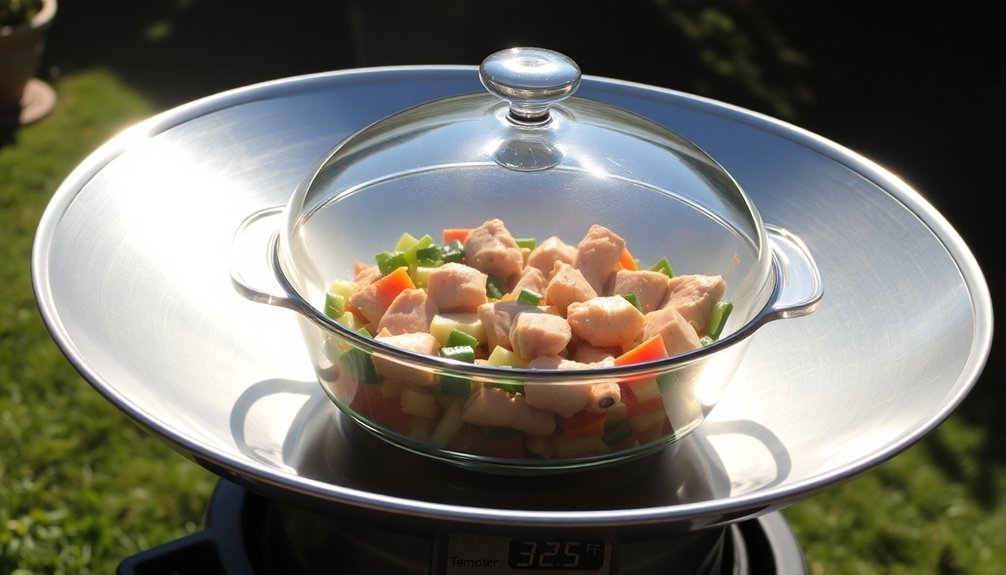
Solar cooking harnesses the sun's energy to prepare meals through specialized equipment that captures and concentrates heat.
You'll find several options, from box cookers that reach 300°F to parabolic models hitting 400°F, and portable panel cookers perfect for outdoor adventures.
To get started, you'll need to preheat your solar cooker for 15-30 minutes in direct sunlight.
Use dark, heat-absorbing pots with lids, and cut food into smaller pieces to reduce cooking time.
You'll want to adjust the cooker's position throughout the day to maximize sun exposure.
Beyond saving money on energy bills, you're making an eco-friendly choice.
Solar cooking prevents millions of metric tons of CO2 emissions and helps preserve forests by reducing firewood needs.
Plus, your food retains more nutrients, with 10-20% higher protein content than conventional cooking methods.
Time-Saving Sunlit Cooking Methods
Smart meal preppers are discovering the time-saving benefits of solar cooking, which lets you multitask while your food cooks slowly in the sun.
While your meals heat to 200-250°F over 2-4 hours, you're free to tackle other tasks, only needing to adjust the cooker's position every couple of hours.
You can maximize efficiency by batch cooking staples like proteins, root vegetables, and legumes for use throughout the week.
The process works similarly to a slow cooker, making it perfect for meal prep favorites:
- Pre-cook beans, grains, and eggs that you'll portion into weekday lunches
- Prepare multiple servings of soups and stews for easy reheating
- Steam large batches of vegetables while working from home
For best results, use dark, thin-walled pots with lids to enhance heat absorption and retention.
Sustainable Food Storage Solutions
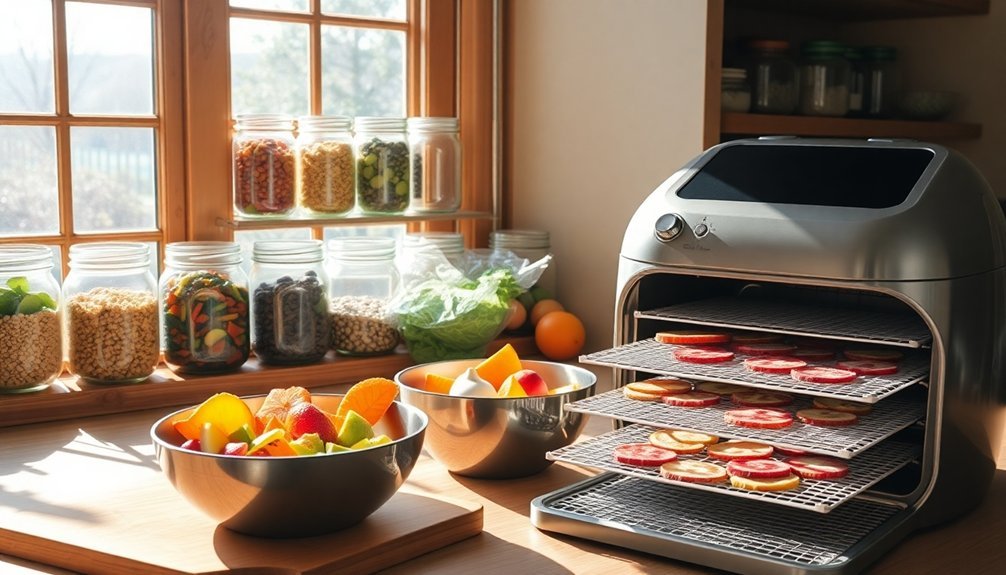
When storing your meal-prepped foods in glass containers, you'll want to place them in areas of your kitchen that receive indirect natural light, as direct sunlight can affect food quality and temperature.
Glass containers with airtight silicone or eco-friendly lids work best for maintaining freshness while allowing you to easily spot your prepared ingredients.
Consider organizing your storage zones based on natural lighting patterns – keep temperature-sensitive items in darker spots while positioning hardier ingredients in brighter areas where you can easily monitor their condition.
Glass Container Best Practices
Making the switch to glass containers represents one of the most impactful decisions you'll make for sustainable food storage.
You'll protect your health by avoiding toxic chemicals like BPA and phthalates, while ensuring your food stays fresh and contamination-free. These versatile containers can handle extreme temperatures, making them perfect for both freezer storage and oven heating.
- Clean your containers thoroughly after each use – their non-porous surface prevents bacteria buildup and unwanted odors.
- When moving from freezer to oven, allow containers to adjust to room temperature gradually to prevent thermal shock.
- Consider investing in quality silicone or glass lids for an entirely plastic-free storage solution.
You'll save money in the long run while supporting environmental sustainability, as glass containers last longer and can be recycled when needed.
Natural Light Storage Zones
Proper use of natural light in your food storage areas offers a sustainable and chemical-free approach to meal prep organization.
You'll find that sunlight naturally deodorizes containers and helps prevent mold growth while maintaining food freshness in well-ventilated spaces.
Set up your storage zones by choosing containers that work well with natural light. Bamboo, beeswax wraps, ceramic, and stainless steel options are ideal.
Stack these containers strategically to guarantee each item receives adequate sunlight exposure, and keep highly perishable items visible as a reminder to use them first.
You're not just organizing – you're contributing to eco-friendly living.
By utilizing natural light, you'll reduce your reliance on artificial lighting and preservatives while maintaining food quality.
This approach pairs perfectly with reusable containers, minimizing your environmental impact and supporting sustainable practices.
Seasonal Solar Cooking Guide
Since solar cooking relies heavily on natural light patterns, understanding seasonal variations is essential for successful meal preparation.
You'll find that summer offers the most flexibility, with cooking windows stretching from mid-morning to late afternoon. In contrast, winter demands strategic timing due to shorter daylight hours and the sun's lower position.
- Plan your winter cooking between 11:00 am and 3:00 pm when the sun's angle is most favorable
- Take advantage of summer's extended daylight by starting as early as 10:00 am and finishing warming stages by 4:00 pm
- Adjust your cooking schedule based on your location – southern regions offer more consistent year-round options than northern areas
Remember to position your solar cooker for maximum sun exposure and consider using dark-colored pots to enhance heat absorption during challenging seasons.
Energy Cost Reduction Strategies

When you adopt smart energy-saving practices in your kitchen, you'll notice a significant drop in utility bills while maintaining cooking quality.
Start by matching your cookware to burner sizes and keeping lids on pots to reduce heat loss by up to 66%. You'll save significant energy by using your microwave for reheating instead of the oven, cutting energy use by 80%.
Choose energy-efficient appliances with ENERGY STAR® labels and opt for small appliances like air fryers and slow cookers when preparing smaller meals.
When using your oven, switch to convection mode to reduce cooking time by 20% and lower temperatures by 25 degrees. Maximize efficiency by cooking multiple items at once and using the oven light instead of opening the door.
Don't forget to batch-cook ingredients and freeze extra portions to minimize future energy use.
Window Placement For Cooking
The strategic placement of kitchen windows can transform your meal prep experience while maximizing natural light and energy efficiency.
Consider installing south-facing windows to capture consistent daylight throughout your cooking hours, or east-facing windows if you're an early morning meal prepper.
For tasks requiring precise knife work or ingredient measuring, north-facing windows provide even, glare-free illumination that won't interfere with your prep work.
- Install casement windows near your prep station for unobstructed views and easy ventilation while chopping vegetables.
- Place a bay window above your sink to create a bright, functional space for washing produce and herbs.
- Add a skylight over your main cooking area if wall space is limited, bringing natural light directly to your stovetop.
Optimal Light Kitchen Workflow
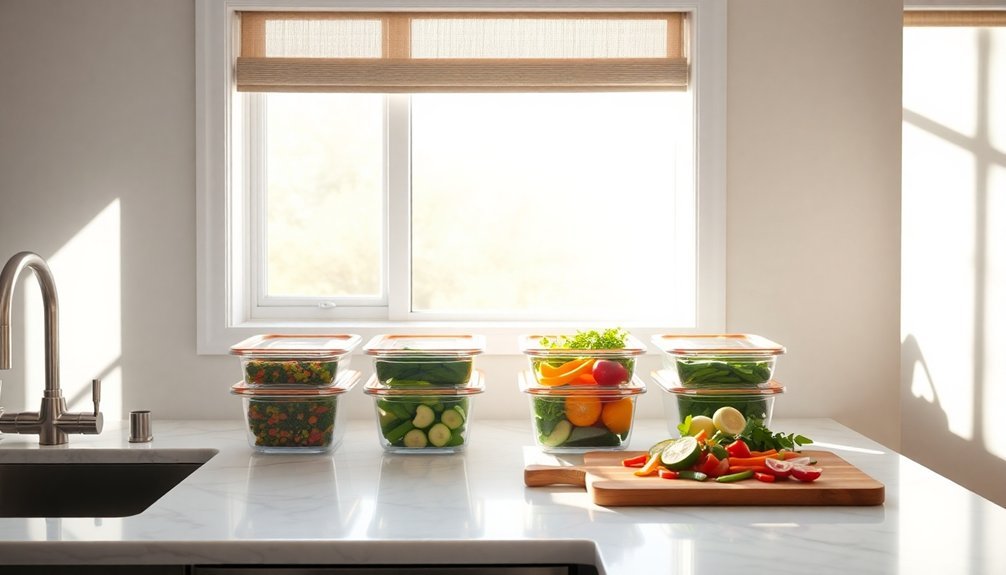
Creating an ideal kitchen workflow requires thoughtful integration of natural and artificial lighting throughout your space.
You'll want to position your meal prep stations where natural light floods in without casting shadows on your work surface. Add task lighting above cutting boards and cooking areas to guarantee precise food handling when sunlight isn't enough.
Install dimmers and smart lighting solutions so you can adjust brightness levels as the day progresses.
You'll find LED bulbs particularly useful for long prep sessions, as they're energy-efficient and provide consistent illumination.
Consider placing reflective surfaces or mirrors strategically to bounce light into darker corners.
Layer your lighting with a mix of ambient and accent fixtures to maintain visibility while creating an inviting atmosphere that'll keep you motivated during extended meal prep sessions.
Frequently Asked Questions
Can Meal Prepping With Sunlight Work in Apartments With Limited Window Exposure?
You'll face challenges with limited window exposure, but you can still make it work by using reflective surfaces, positioning your prep area near windows, and timing your activities when sunlight's strongest.
How Does Cloudy Weather Affect Vitamin D Absorption During Meal Prep?
Cloudy weather reduces your vitamin D absorption during meal prep since clouds filter UVB rays. You'll still get some benefits, but it's less effective – expect around 30-70% less vitamin D production depending on cloud coverage.
Which Kitchen Tools Maximize Natural Light Reflection While Meal Prepping?
You'll get the best light reflection from stainless steel mixing bowls, metallic measuring cups, polished utensils, and glass storage containers. Position these tools near windows or under bright lights while prepping meals.
Does Sunlight Exposure Affect Food Safety During Longer Prep Sessions?
Yes, sunlight exposure seriously compromises your food safety. You shouldn't leave perishables out for more than one hour in the sun, as it rapidly promotes bacterial growth and toxin production that can't be eliminated by cooking.
Can Seasonal Changes in Sunlight Patterns Impact Meal Prep Scheduling?
You'll need to adjust your meal prep timing as daylight hours shift seasonally. In winter, start earlier to maximize natural light, while summer's extended daylight gives you more flexibility for evening prep sessions.
In Summary
You'll find meal prepping with sunlight transforms your kitchen routine while reducing your carbon footprint. By organizing your workspace around natural light and adopting solar cooking methods, you're not just saving on energy bills – you're creating a more sustainable cooking environment. Take advantage of seasonal sunlight patterns, optimize your window placement, and watch as your meal prep becomes more efficient and environmentally conscious.

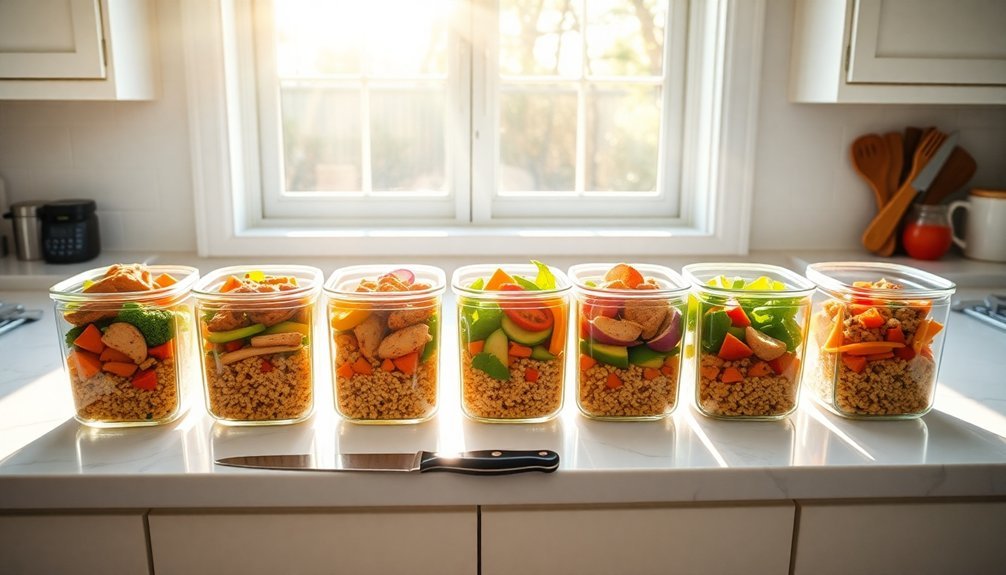



Leave a Reply